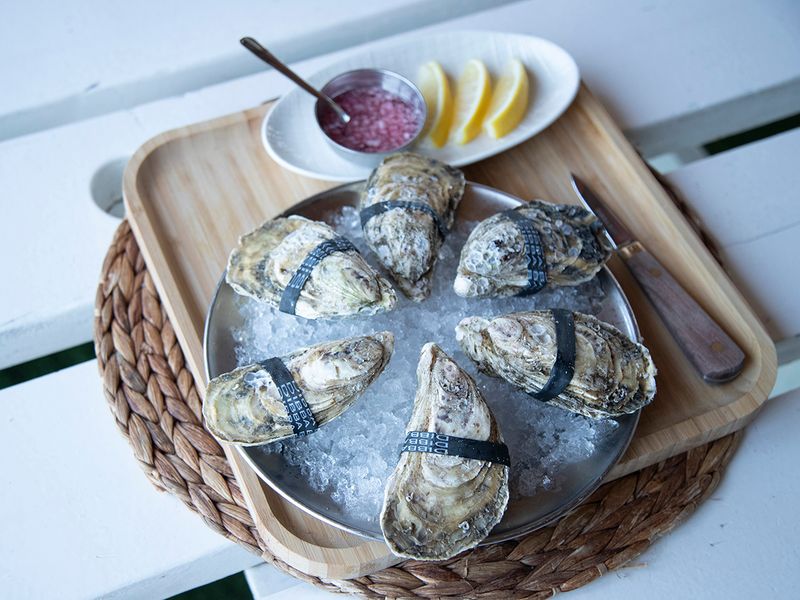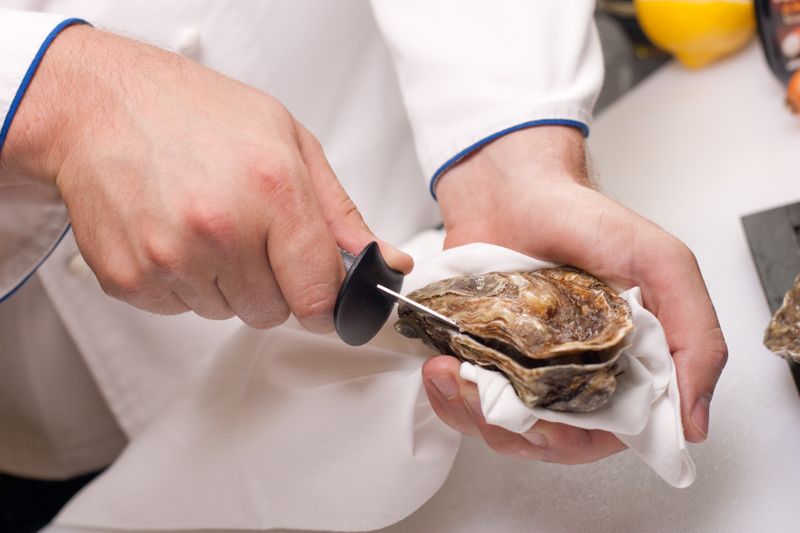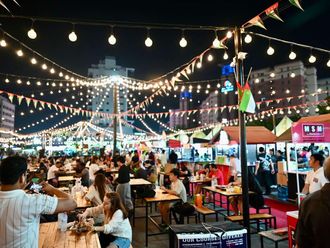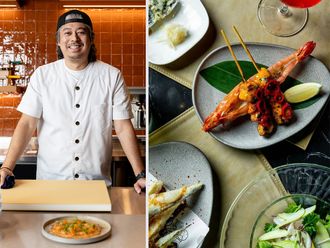
From a quiet market town in Scotland, called Cupar, Ramie Murray’s family moved to bustling, sunny Dubai when he was 12. This was 1993. Growing up in the UAE, Murray had one ambition – to start a sustainable business. Now, the 42-year-old Dubai resident owns the first ever locally grown edible oyster farm in the UAE with production of over 400,000 oysters monthly and the shellfish from his farm are being eaten at top restaurants across the country.
Growing up in UAE
Murray went to school in Dubai and briefly returned to Scotland for university. Coming back to the UAE after graduating, he started his first business. It was very different from what he does now as founder and CEO of Dibba Bay Oysters, he started a graphic design company.
Starting an enterprise was natural to him, his mother also ran her own business in the UAE. “Starting my own thing seemed normal,” Murray said.
“I studied industrial design and product design but aquaculture and the food industry were always something that interested me,” he said.
He then moved into the renewable energy business in Oman and worked on a solar energy farm. Working there, he started looking into lobster farming.
“Growing up I came across a lot of Omani lobsters being served in the UAE but I realised that locally produced lobster was really hard to come by [in Oman], so I wanted to know why that was. So initially I wanted to start a lobster farm. When I started looking at the space, I looked at other species that could work in the region,” he said.
Hence, the idea to try farming oysters in the UAE was born.
Filling the gap
“There were lots of oysters being imported into the UAE. Dubai imports a huge amount of seafood, primarily from Europe, mainly France, however, there was no local production,” he said.
Speaking about the initial stages of starting the venture, he said: “We needed to do a pilot study before starting the business and it went really well and we took it from there.”

Were restaurants and diners in the UAE ready for it? Well, according to Murray, the reception was great and naturally, it is ideal for seafood that is generally eaten raw, such as oysters, to be produced as closely as possible to where they are being served.
“People are interested in eating oysters from where they are as it is a raw product. Right up until the last moment [before being consumed] so freshness is key. Having it produced locally is a big deal,” he said.
Why Fujairah’s waters are perfect
So Murray got to researching and found that the waters off the eastern coast in the UAE may provide an ideal environment for oysters to grow.
“We identified oysters as something that on paper should work on the east coast of Fujairah but just hadn’t been tried, so it was important to do a pilot study, which was a great success,” he said.
Having the temperature within the range in which these oysters can grow is important as well as the water having enough nutrients to feed them.
“People always think that oysters can only be grown in very cold temperatures. Well, we now know that it's actually more to do with food supply than [the] cold. Usually, because there’s more algae and food available in cold oceans.
“It turns out that Fujairah breaks that trend completely because it is very deep over there, there’s an upwelling of nutrients and it is also a bit cooler than Dubai. There is plenty of food,” he said.
According to Murray, the ideal conditions would be to have nutrient rich water with a lot of algae and phytoplankton and the water to be as cool as possible and less saline – and Fujairah’s waters provided just that.
“The species we are growing are the Pacific cupped oysters. These particular species are highly adaptable. They have a huge environmental range and can survive in very low and high temperatures – everywhere from Alaska, and Scotland to Fujairah,” he said.
Gulf News spoke to Sabhah Alhmoudi, a marine researcher at the Fujairah Research Center (FRC), an entity based in the emirate, which focuses on “applied research and technology innovation for desert and tropical areas and encompasses environmental, genetic, and marine”. She shared more on how the water in Fujairah is an ideal environment for oyster farming.
“The waters in northern Fujairah are pristine, and thanks to the ideal temperatures in the waters on the east coast of the UAE and the rich density of phytoplankton that’s available for most of the year, it’s the perfect combination to grow oysters. It's not possible for these oysters to be grown in other parts of the UAE due to higher salinity and temperatures,” she said.
Business aspect
So, through research Murray learnt that oyster farming was doable in the UAE and an idea for a successful business plan was there. But he needed funding along with his drive to start a UAE-born aquaculture business.
“It was a typical friends and family supported business at first. They got us going,” he said. Murray also used the profit he had made running the graphic design company to start the farm.
Murray also credits his background growing up as an expat in the UAE for his success and being able to take care of the logistics of starting a business. “I had huge advantages as someone who grew up here knowing how things work and how the culture works.”

In 2018 we were only doing 20,000 oysters per month but after 2019, we are getting 400,000 oysters monthly
In 2016, the Dibba Bay Oysters farm was born. The harvest slowly grew. “In 2018 we were only doing 20,000 oysters per month but after 2019, we are getting 400,000 oysters monthly,” he said.
“In 2019, we had a big expansion. We had a large investment and that’s what really enabled us to take a big step up in production,” he added.
However, Murray shared that at first, there was apprehension regarding the oysters amongst the food businesses and chefs he initially approached.
“There was initially quite a bit of disbelief by chefs in the UAE, as I started to introduce Dibba Bay Oysters, however, once I managed to get them to actually take the time to try them, the response was almost always ‘good! surprisingly good!’. Their initial hesitancy was always understandable, and I didn't take it personally as what I was doing was a regional first and no one was expecting it - but it was always satisfying to pleasantly surprise the chefs,” he said.
Now, Dibba Bay Oysters also have two restaurants in Dubai, mainly serving shellfish.
A sustainable cycle
One thing that was clear to Murray from the beginning of his venture is that he wanted his business to be sustainable.
“Once I got interested in the aquaculture space, one thing that I knew is that when I got into farming, it had to be sustainable farming. I wanted to grow something in the natural environment here,” he said.
Speaking about how oyster farming innately fits into his values, he said: “Shellfish farming is naturally sustainable. The oysters need no artificial feed or medication and have no negative impact on their surroundings. They improve water quality and the nets we are holding them in are providing habitat for other species as well.”
Dibba Bay Oysters collaborated with FRC to verify their sustainable practices.
“The FRC came along and they provided reliable government verified testing of the area because for oyster farming it is extremely important that we have good, clean water. Oysters are sucking in whatever is there in their environment,” Murray said.
“This is a big problem in other parts of the world due to pollution. We are very lucky that in northern Fujairah, in the Dibba area, the environment is very pristine. No heavy industry or population and no rivers,” he added.
In a joint effort with the FRC, Murray’s farm started a project to help the production of local pearl oysters using the used shells his restaurants produce.
“In nature when shellfish reproduce, free-swimming larvae are produced and what they need is to settle on a fragment of an old oyster shell to then start building their own shell. So, we collect all our used shells at our restaurants and we put them back into the ocean in collaboration with FRC,” he said.
This process needs to be monitored and regulated, which the FRC provides.
“They help us manage and regulate putting back the shells into the water. It provides an environment for the local pearl oysters to reproduce in, which helps in rebuilding traditional pearl oyster reefs,” Murray said.
Alhmoudi, from FRC, also said that the lantern baskets, in which the oysters are grown, help provide food for other fish in the water.
“The lantern baskets used at the Dibba Bay Oysters farm act as hanging reefs which create habitat for aquatic life in the area - the area is almost like a fish nursery where tons of baby fish will feed off the biomass that is formed off the lantern baskets. We see ecosystems being supported through the presence of turtles, vegetation, and other marine life present in the area,” she said.
The growth of marine life in the area is also benefiting the local fishermen and the fishing industry, Fujairah is known for.
“[…] there are so many fish that the fishermen have placed their traps all around the farm because of all the fish that gravitate towards the area,” she said.
UAE-based food production
Speaking about an increase in locally-grown produce and ingredients, he said: “There is definitely more interest in locally produced food. I’d like to think we contribute to that in a small way.”
How to store and enjoy oysters
If you’re new to trying oysters and happen to get some to enjoy, Murray shared his tips on storing them.
Store them in their wooden box in the fridge with the lid on, he recommends. “As long as they are in their box with the lid, there’s no need to put any wet towels or transfer them to another storage box or anything. The wooden box maintains a good micro climate for them,” he said.
The standard temperature in a fridge is usually at 3°C and according to Murray, “…the oysters should be okay for at least a week at that temperature”.
“However, they actually prefer it a bit warmer so if you happen to have a beverage fridge that's closer to 10°C, then that can often double the shelf life,” he added.
US-based food website, foodrepublic.com, recommends cleaning the oysters under running cold water thoroughly. If there are any open shells, discard them.

Place a clean hand towel on the counter top and place the oyster on that towel and then use another towel to hold the oyster in place. Then to open the oyster, insert the tip of an oyster knife into the hinge of the shell.
Using a little pressure, move your oyster knife so that you separate the top and bottom shells. Once the oyster is open, loosen the oyster from its shell so that it can be slurped easily. Use the oyster knife to gently scrape the oyster and detach it from the shell.
The liquid in the shell is called the oyster liquor and it is cherished amongst those who enjoy the shellfish, so do not discard the liquid.
When ready to enjoy the oysters, Murray said: “I prefer to eat with some grape vinaigrette with finely chopped shallots, traditional French style.” This sauce served with oysters is called a mignonette. Shellfish lovers who want to savour the flavour of the oysters also have them with just a squeeze of lemon. Stewed, steamed and fried oysters are also popular.
If you are not a fan of raw seafood, we have a recipe for Panko Fried Oysters.


















